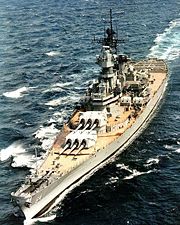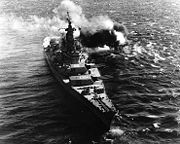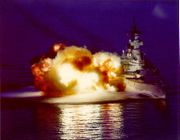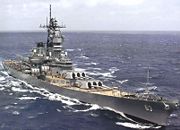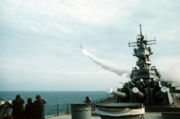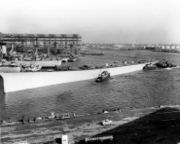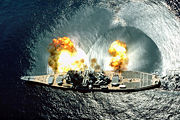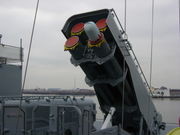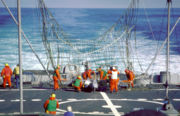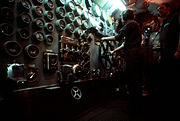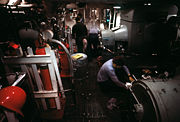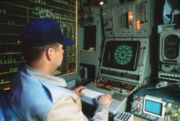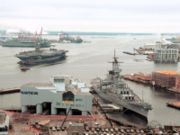Iowa class battleship
2008/9 Schools Wikipedia Selection. Related subjects: Military History and War
 USS Iowa (BB-61) fires her 16-inch/50-caliber guns during a fire power demonstration sometime after her 1980s modernization. |
|
| Class overview | |
|---|---|
| Name: | Iowa class battleship |
| Builders: | New York Navy Yard Philadelphia Navy Yard Norfolk Navy Yard |
| Operators: | |
| Preceded by: | South Dakota class battleship |
| Succeeded by: | Montana class battleship |
| In service: | 22 February 1943 - 17 March 2006 |
| In commission: | 22 February 1943 - 31 March 1992 |
| Completed: | 4 |
| Cancelled: | Illinois Kentucky |
| Retired: | 4 |
| Preserved: | Iowa New Jersey Missouri Wisconsin |
| General characteristics | |
| Type: | Battleship |
| Displacement: | 45,000 tons (standard); 52,000 tons (mean war service); 58,000 tons (full load) |
| Length: | 861¼ ft (262.5 m) between perpendiculars 890 ft (271 m) overall |
| Beam: | 108 ft (33 m) |
| Draught: | 36 ft (11 m) maximum |
| Propulsion: | 4 screws; geared turbines; 8 Babcock & Wilcox Boilers; G.E. (BB-61;BB-63); West. (BB-62; BB-64; BB-66); 212,000 shp (158,000 kW) |
| Speed: | 33 knots (61 km/h) nominal 35 knots (65 km/h) maximum |
| Range: | 9,600 miles (15,000 km) @ 25 knots (46 km/h); 16,600 miles (27,000 km) @ 15 knots (28 km/h) |
| Complement: |
|
| Armament: |
|
| Armor: | Belt: 12.1 in (310 mm), Bulkheads: 11.3 in (290 mm), Barbettes: 11.6 to 17.3 in (295 to 439 mm), Turrets: 19.7 in (500 mm), Decks: 7.5 in (190 mm) |
| Aircraft carried: |
|
The Iowa-class battleships were a planned class of six fast battleships ordered by the United States Navy in 1939 and 1940 to escort the Fast Carrier Task Forces that would operate in the Pacific Theatre of World War II. Four were completed in the early to mid-1940s; two more were laid down, canceled prior to completion, and ultimately scrapped. They comprised the final class of U.S. battleships to be built.
Built with no regard for cost, the Iowa class was arguably the ultimate in the evolution of the capital ship. The ships topped the Discovery Channel's list of the ten "most fearsome vessels in the history of naval warfare." Yet even as these leviathans entered service, they were being eclipsed by aircraft carriers as the most important naval vessels.
The Iowa-class battleships served in every major U.S. war of the mid and latter half of the 20th century. In World War II, they defended aircraft carriers and shelled Japanese positions before being placed in reserve at the end of the war. Recalled for action during the Korean War, the battleships provided artillery support for UN forces fighting against North Korea. In 1968, New Jersey was recalled for action in the Vietnam War and shelled Communist targets near the Vietnamese Demilitarized Zone. All four were reactivated and armed with missiles during the 1980s as part of the 600-ship Navy. In 1991, Missouri and Wisconsin fired missiles and 16-inch (406 mm) guns at Iraqi targets during the Gulf War. All four battleships were decommissioned in the early 1990s as the Cold War drew to a close, and were initially removed from the Naval Vessel Register; however, at the insistence of the United States Congress, two were reinstated to the Naval Vessel Register for maintenance in the mothball fleet in 1995. These last two battleships were removed from the Naval Vessel Register in 2006.
History
The Iowa-class battleships were shaped by the Battle of Jutland, by naval treaties signed by various countries during the 1920s and 1930s, and by the need to keep up with aircraft carriers and protect them from aerial attack.
During the Battle of Jutland in 1916 three Royal Navy battlecruisers were lost due to inadequate armor protection. As a result of this loss, naval architects for the world's major naval powers set out to improve their naval armor to prevent such a loss from recurring, leading to so-called "Post Jutland" hull designs with greater armor protection.
The Washington Naval Treaty was proposed by U.S. Secretary of State Charles Evans Hughes and forged during a November 1922 conference attended by Great Britain, France, Italy, and Japan. The attending nations agreed to abandon ongoing construction of battleships and battlecruisers, to limit ships to 35,000 tons, to cap armament at 16-inch (406 mm) cannons, and to limit replacement tonnage. The London Naval Treaty further restricted battleship construction and banned new battleships through 1937. These treaties stopped U.S. construction of battleships and battlecruisers.
At the Second London Naval Conference in 1935, the Empire of Japan denounced the naval treaty and withdrew its delegates. The other conferees agreed that if Japan did not sign the treaty by April 1937, other nations would be free to build guns up to 16 inches (410 mm), the maximum size under the Washington Naval Treaty. Tonnage limits would also be relaxed.
That same year (1935), an empirical formula for predicting a ship's maximum speed was developed, based on scale-model studies in flumes of various hull forms and propellers. The formula used the length-to-speed ratio originally developed for 12-meter yachts: Speed = √1.408 * waterline length, and was later redefined as Capital Ship Speed = 1.19 * √Length at Waterline. It quickly became apparent that propeller cavitation caused a drop in efficiency at speeds over 30 knots (55.56 km/h). Propeller design therefore took on new importance.
In 1936, on the heels of the Empire of Japan's withdrawal from the Second London Naval Conference, President Franklin Roosevelt issued an executive order creating the Battleship Design Advisory Board (BDAB) and charged the new group with developing new battleship designs, in particular for a 45,000-ton battleship. The board, composed of renowned U.S. naval architects and headed by Captain Allan Chantry, played with various designs for the upcoming U.S. fleet of North Carolina and South Dakota-class battleships to help lessen the gap between the U.S. based battleships and those being commissioned in Germany and Japan at the time.
The United States began building the North Carolina and South Dakota-class battleships in the late 1930s. Designed mostly within treaty limitations, these new battleships could steam at 28 knots (52 km/h), fast for a battleship but not fast enough to keep pace with the aircraft carriers being planned.
Birth of the Iowa class
The Iowa class, like the South Dakota class and North Carolina class, began in response to the need for fast escorts for the Essex-class aircraft carriers. Plans for fast battleships that displaced 45,000 tons had been under development since 1935, beginning with a study of the idea of creating an extended South Dakota class that would take full advantage of the escalator clause of the Second London Naval Treaty. When the Second Vinson Act was passed by the United States Congress in 1938, the U.S. Navy moved quickly to develop a 45,000-ton battleship that would pass through the 110 ft (34 m) wide Panama Canal. Drawing on the earlier speed equations and a newly developed empirical theorem that related waterline length to maximum beam, the Navy drafted plans for a battleship class with a maximum beam of 108 ft (32.9 m), which when multiplied by 7.96 produced a waterline length of 860 ft (262 m), permitting a maximum speed of 34.9 knots (64.6 km/h). The Navy also called for the class to have a lengthened forecastle and amid-ship, which would increase speed, and a bulbous bow.
As with the preceding battleship classes, the Iowa-class battleships were " Panamax" ships —built within the size limits required to transition the Panama Canal. The main reason for this was logistical: the largest U.S. shipyards were located on the East Coast of the United States, while the United States had territorial interests in both oceans. Requiring the battleships to fit within the Panama Canal shaved days off the transition time from the Atlantic Ocean to the Pacific Ocean by allowing ships to move through the canal instead of sailing all the way around South America.
Originally, the ships were to mount the Mark 2 16-inch (406 mm) / 50- caliber gun, which had been intended to arm the battleships and battlecruisers canceled in 1922. But due to a miscommunication between the Bureau of Ordnance and the Bureau of Construction and Repair that left the ship's barbettes too small, the Mark 2 guns were replaced in the design by the new, lighter Mark 7 16-inch 50-caliber gun. The Mark 7 was heavier and had a greater range than the 16"/45 Caliber Mark 6 guns used on the preceding North Carolina and South Dakota classes. The Mark 7 was originally intended to fire the same 2,240 lb (1,020 kg) shell as the 16-in/45-caliber gun, but as the design was being completed a new "super-heavy" 2,700 lb (1,200 kg) shell was developed for both guns. However, the Iowa's armor was only designed to resist 2,240 lb (1,016 kg) shells, as adding armor would have pushed the ship's weight over the 45,000-ton limit.
At the time the Iowa-class had been cleared for construction, the United States Congress had allocated only enough money to construct the first two ships (Iowa and New Jersey). Congress had not expected the Iowa-class to be so costly; with a price tag of $125 million per ship, the Iowas were 60% more expensive than the previously authorized battleship classes. Moreover, some policymakers were not sold on the U.S. need for more battleships, and proposed turning the ships into aircraft carriers by retaining the hull design but switching their decks to carry and handle aircraft. The proposal to build the Iowas as aircraft carriers was countered by Admiral Ernest King, the Chief of Naval Operations, and Congress' position on the funding for the Iowa-class changed after the Fall of France, when Roosevelt demanded that Congress fund a two ocean navy to meet the threats posed in the Atlantic and Pacific Oceans. Concern over the German invasion prompted Congress to respond by allotting enough money to complete the last four Iowa-class battleships (Missouri, Wisconsin, Illinois, and Kentucky).
Under the direction of Secretary of the Navy Charles Edison, the design was finalized and a contract was signed with the shipyards in July 1939 for the construction of BB-61, BB-62, BB-63, and BB-64 (all Iowa-class battleships) along with BB-65 and BB-66, the first two ships of the Montana-class of battleships. By 1942, however, the United States Navy shifted its building focus from battleships to aircraft carriers after the successes of carrier combat in both the Battle of Coral Sea, and to a greater extent, the Battle of Midway. As a result, the construction of the U.S. fleet of Essex-class aircraft carriers had been given the highest priority for completion in the U.S. shipyards by the U.S. Navy. The Essex-class carriers required escorts that could steam with the carriers at a comparable speed, which prompted the U.S. Navy to reorder BB-65 and BB-66 as Iowa-class battleships, enabling both battleships to steam at a comparable speed with the Essex-class and provide the carriers with the maximum amount of anti-aircraft protection.
Service history
When brought into service during the final years of World War II, the Iowa-class battleships were assigned to operate in the Pacific, primarily to provide anti-aircraft screening for U.S. aircraft carriers and perform shore bombardment. Among the Iowas, only USS New Jersey engaged a surface ship during World War II. At the end of the war, Iowa, New Jersey and Wisconsin were decommissioned and placed in the mothball fleet; construction on two uncompleted ships (Illinois and Kentucky) was halted.
The Iowas were recalled in 1950 with the outbreak of the Korean War, then returned to mothballs after hostilities ceased, in 1955.
In 1968, due in large part to congressional pressure, New Jersey was recommissioned and sent to assist U.S. troops during the Vietnam War. She did one tour on the firing line, then was decommissioned the following year.
In the 1980s, the battleships were recommissioned. President Ronald Reagan had vowed to rebuild the U.S. military and create a 600-ship Navy. With the Des Moines-class heavy cruisers worn out, the relatively low mileage Iowas were brought back to fill the offshore bombardment role. The ships also provided a counter to the new Soviet Orlan-class large missile cruisers, better known in the West as the Kirov-class battlecruisers. Each battleship was modernized to carry electronic warfare suites, CIWS self-defense systems, and missiles. They became the centerpieces of their own battleship battle groups (BBBGs). Their missions in the 1980s and early 1990s included the U.S. intervention in the Lebanese Civil War following the 1983 Beirut barracks bombing and the 1991 Gulf War, first as part of Operation Desert Shield and then as part of Operation Desert Storm. Decommissioned for the last time in the early 1990s, the Iowas were split into two groups: those retained in the United States Navy reserve fleets (better known as the "mothball fleet") and those donated for use as museum ships.
In 1996, the National Defense Authorization Act led Iowa and Missouri to be struck from the Naval Vessel Register. Missouri was donated to the Missouri Memorial Association of Pearl Harbour, Hawaii, for use as a museum ship. Iowa was set to be donated with Missouri, but was reinstated to the Naval Vessel Register after the Strom Thurmond National Defense Authorization Act of 1999 allowed New Jersey to be donated as a museum ship. The last two Iowa-class battleships were removed from the mothball fleet in 2006, and are currently awaiting transfer for use as museum ships.
The ships
The Iowa-class ships were built to steam at the same speed as the U.S. fleet of Essex-class aircraft carriers. Their main battery and secondary battery guns were designed to take on the ships of the Imperial Japanese Navy, and to shell beachheads in advance of U.S. Army and Marine Corps amphibious assaults. They carried a fearsome array of anti-aircraft guns to defend themselves and their carriers.
USS Iowa (BB-61)
Iowa was ordered 1 July 1939, laid down 27 June 1940, launched 27 August 1942, and commissioned 22 February 1943. Iowa conducted a shakedown cruise in the Chesapeake Bay before sailing to Naval Station Argentia, Newfoundland to counter the German battleship Tirpitz. Transferred to the Pacific Fleet in 1944, Iowa made her combat debut in the campaign for the Marshall Islands. The ship escorted U.S. aircraft carriers conducting air raids in the Marianas campaign, then was present at the Battle of Leyte Gulf. During the Korean War, Iowa bombarded enemy targets at Songjin, Hungnam, and Kojo, North Korea. Iowa returned to the U.S. for operational and training exercises before being decommissioned. Reactivated in the early 1980s, Iowa made several operation cruises in European waters. On 19 April 1989, an explosion of undetermined origin ripped through her No. 2 turret, killing 47 sailors. The turret remained inoperable when Iowa was decommissioned for the last time in 1990. In 1999, Iowa was placed in the mothball fleet as a replacement for sister ship New Jersey. Stricken from the Naval Vessel Register on 17 March 2006, Iowa is currently berthed at Suisun Bay in San Francisco, California, pending a decision on requests to turn the ship into a museum ship.
USS New Jersey (BB-62)
New Jersey was ordered 1 July 1939, laid down 16 September 1940, launched 7 December 1942, and commissioned 23 May 1943. New Jersey completed fitting out and trained her initial crew in the Western Atlantic and Caribbean before transferring to the Pacific Theatre in advance of the planned assault on the Marshall Islands, where she screened the U.S. fleet of aircraft carriers from enemy air raids. At the Battle of Leyte Gulf, the ship protected carriers with her anti-aircraft guns. New Jersey then bombarded Iwo Jima and Okinawa. During the Korean War, the ship pounded targets at Wonsan, Yangyang, and Kansong. Following the ceasefire, New Jersey conducted training and operation cruises until she was decommissioned. Recalled for action in 1968, New Jersey reported for duty near the Vietnam DMZ, and remained there until 1969, whereupon she was again decommissioned. Reactivated under the 600-ship Navy program, New Jersey was sent to Lebanon to protect U.S. interests and U.S. Marines, firing her main guns at Druze and Syrian positions in the Bekaa valley east of Beirut. Decommissioned for the last time 8 February 1991, New Jersey was briefly retained on the Naval Vessel Register before being donated to the Home Port Alliance of Camden, New Jersey, for use as a museum ship.
USS Missouri (BB-63)
Missouri was ordered 12 June 1940, laid down 6 January 1941, launched 29 January 1944, and commissioned 11 June 1944. Missouri conducted her trials off New York and shakedown and battle practice in the Chesapeake Bay before transferring to the Pacific Fleet, where she screened U.S. aircraft carriers involved in offensive operations against the Japanese before reporting to Okinawa to shell the island in advance of the planned landings. Following the bombardment of Okinawa Missouri turned her attention to Honshū and Hokkaidō, shelling the islands and screening U.S. carriers involved in combat operations against the Japanese positions. She garnered international attention in September 1945 when representatives of the Empire of Japan boarded the battleship to sign the documents of unconditional surrender to the Allied powers. After World War II Missouri turned her attention to conducting training and operational cruises before being dispatched to Korea at the outbreak of the Korean War. Missouri served two tours of duty in Korea before being decommissioned in 1956. Reactivated 1984 as part of the 600-ship Navy plan, Missouri was sent on operational cruises until being assigned to Operation Earnest Will in 1988. In 1991, Missouri participated in the Gulf War by firing Tomahawk Missiles at Iraqi target and shelling known Iraqi positions along the coast. Decommissioned for the last time in 1992, Missouri was donated to the USS Missouri Memorial Association (MMA) of Pearl Harbour, Hawaii, for use as a museum ship in 1999; as of 2008 she stands at dock near the USS Arizona (BB-39).
USS Wisconsin (BB-64)
Wisconsin was ordered 12 June 1940, laid down 25 January 1942, launched 7 December 1943, and commissioned 16 April 1944. After trials and initial training in the Chesapeake Bay, Wisconsin transferred to the Pacific Fleet in 1944 and assigned to protect the U.S. fleet of aircraft carriers involved in operations in the Philippines until summoned to Iwo Jima to bombard the island in advance of the Marine landings. After the landings on Iwo Jima she turned her attention to Okinawa, bombarding the island in advance of the allied amphibious assault. In mid-1945 Wisconsin turned her attention to pounding the Japanese home islands, a job she retained until the surrender of Japan. Reactivated in 1950 for the Korean War, Wisconsin served two tours of duty assisting South Korean and UN forces by providing call fire support and shelling targets of opportunity. Decommissioned in 1958, Wisconsin was placed in the reserve fleet at the Philadelphia Naval Yard until reactivated in 1986 as part of the 600-ship Navy plan. In 1991, Wisconsin participated in the Gulf War by firing Tomahawk Missiles at Iraqi targets and shelling Iraqi troop formations along the coast. Decommissioned for the last time 30 September 1991 Wisconsin was placed in the reserve fleet until struck from the Naval Vessel Register 17 March 2006. She is currently berthed in Norfolk, Virginia, pending a formal transfer of the battleship for use as a museum ship.
USS Illinois (BB-65)
Illinois was ordered 9 September 1940 and laid down 15 January 1945. Construction was canceled 11 August 1945 when Illinois was 22% complete. She was sold for scrap in September 1958. Illinois' design called for an all-welded hull, lighter and stronger than the riveted/welded hull of the four completed Iowa-class ships. A proposal to redesign the hull with a Montana-class type torpedo protection system was rejected.
USS Kentucky (BB-66)
Kentucky was ordered 9 September 1940 and laid down on 6 December 1944. Construction was suspended 17 February 1947 when Kentucky was 72% complete. She was informally launched 20 January 1950 to clear a dry-dock for repairs to Missouri, which had run aground. In 1956, Kentucky’s bow was removed and shipped in one piece across Hampton Roads, where it was grafted on the battleship Wisconsin, which had collided with the destroyer Eaton. Later, Kentucky’s engines were salvaged and installed on the fast combat support ships Sacramento and Camden. Nothing came of several proposals to complete Kentucky as a guided missile ship. Ultimately, Kentucky was sold to Boston Metals Co. for scrap on 31 October 1958. Like Illinois, Kentucky's hull was of all-welded construction, lighter and stronger than the other Iowas, and a proposal to redesign the hull with a Montana-class torpedo protection system was rejected.
Armament
The Iowa-class battleships were among the most heavily armed ships the United States ever put to sea. The main battery of 16-inch (406 mm) guns could hit targets nearly 24 miles (39 km) away with a variety of artillery shells, from standard armor piercing rounds to tactical nuclear charges called "Katies" (from "kt" for kiloton). The secondary battery of 5-inch (127 mm) guns could hit targets nearly 9 miles (14 km) away with solid projectiles or proximity fused shells, and were equally adept in an anti-aircraft role and for damaging smaller ships. When commissioned these battleships carried a fearsome array of 20 mm and 40 mm anti-aircraft guns, which were gradually replaced with Tomahawk and Harpoon missiles, Phalanx anti-aircraft/anti-missile gatling gun systems, and electronic warfare suites. By the time the last Iowa-class battleship was decommissioned in 1992 the Iowas had set a new record for battleship weaponry: No other battleship class in history has had so many weapons at its disposal for use against an opponent.
Main battery
The primary armament of an Iowa-class battleship is nine 16-inch (406 mm) / 50-caliber Mark 7 naval guns, which are housed in three 3-gun turrets: two forward and one aft in a configuration known as "2-A-1". The guns are 66 feet (20 m) long (50 times their 16-inch (410 mm) bore, or 50 calibers, from breechface to muzzle). About 43 feet (13 m) protrudes from the gun house. Each gun weighs about 239,000 pounds (108,000 kg) without the breech, or 267,900 pounds (121,500 kg) with the breech. They fire projectiles weighing from 1,900 to 2,700 pounds (850 to 1,200 kg) at a maximum speed of 2,690 ft/s (820 m/s) up to 24 nautical miles (39 km). At maximum range the projectile spends almost 1½ minutes in flight. The maximum firing rate for each gun on an Iowa-class battleship is two rounds per minute. When firing two broadside per minute a single Iowa-class battleship can put 36,000 pounds (16,000 kg) of ordnance on a target per minute, a figure that can only be matched (and in some cases beaten) by a single B-52 Stratofortress of the United States Air Force, which can carry up to 60,000 pounds (27,000 kg) of bombs, missiles, and mines, or any combination thereof.
Each gun rests within an armored turret, but only the top of the turret protrudes above the main deck. The turret extends either four decks (Turrets 1 and 3) or five decks (Turret 2) down. The lower spaces contain rooms for handling the projectiles and storing the powder bags used to fire them. Each turret required a crew of 94 men to operate. The turrets are not actually attached to the ship, but sit on rollers, which means that if the ship were to capsize the turrets would fall out. The original cost for each turret was US $1.4 million, but this number does not take into account the cost of the guns themselves.
The turrets are "three-gun", not "triple", because each barrel can be elevated independently; they can also be fired independently. The ship could fire any combination of its guns, including a broadside of all nine. Contrary to myth, the ships do not move noticeably sideways when a broadside is fired. The guns can be elevated from −5° to +45°, moving at up to 12° per second. The turrets can be rotated about 300° at about four degrees per second and can even be fired back beyond the beam, which is sometimes called "over the shoulder." The guns are never fired directly forward because of the shape of the bow and risk that firing the guns forward would damage the ship; in addition to this concern, a satellite up-link antenna was mounted at the bow of each battleship when reactivated in the 1980s.
Secondary battery
The secondary battery of the ship consists of 5-inch (127 mm) Mark 12 guns in 10 twin mounts, five each to port and starboard, and four Mark 37 Gun Fire Control Systems. These guns were introduced on destroyers in 1934, but by World War II had been installed on nearly every major U.S. warship. The secondary battery was intended to fight off aircraft. Its effectiveness soon declined as Japanese airplanes became faster, then rose again toward the end of the war because of an upgrade to the Mark 37 Fire Control System and the proximity-fuzed 5-inch shells. During the 1980s modernization, four twin mounts were removed to make room for missiles, the two farthest aft and the two at mid-ship on each side. In the Gulf War, the secondary battery was largely relegated to shore bombardment and littoral defense.
Anti-aircraft batteries
Since they were designed to escort the U.S. fleet of fast attack aircraft carriers the Iowa-class battleships were all outfitted with a fearsome array of anti-aircraft guns to protect U.S. aircraft carriers from Japanese fighters and dive bombers.
Oerlikon 20 mm anti-aircraft guns
The Oerlikon 20 mm anti-aircraft gun was one of the most heavily produced anti-aircraft guns of World War II; The US alone manufactured a total of 124,735 of these guns. When activated in 1941 these guns replaced the 0.50"/90 (12.7 mm) M2 Browning MG on a one-for-one basis. The Oerlikon 20 mm AA gun remained the primary anti-aircraft weapon of the United States Navy until the introduction of the 40 mm Bofors AA gun in 1943.
Bofors 40 mm anti-aircraft guns
Arguably the best light anti-aircraft weapon of World War II, the 40 mm Bofors AA gun was used on almost every major warship in the US and UK fleet during World War II from about 1943 to 1945. Although a descendant of German and Swedish designs, the Bofors mounts used by the United States Navy during World War II had been heavily "Americanized" to bring the guns up to the standards placed on them by the US Navy. This resulted in a guns system set to English standards (now known as the Standard System) with interchangeable ammunition, which simplified the logistics situation for World War II. When coupled with hydraulic couple drives to reduce salt contamination and the Mark 51 director for improved accuracy the Bofors 40 mm gun became a fearsome adversary, accounting for roughly half of all Japanese aircraft shot down between 1 October 1944 and 1 February 1945.
Phalanx CIWS
During their modernization in the 1980s each Iowa-class battleship was equipped with four of the United States Navy's Phalanx CIWS mounts, two which sat just behind the bridge and two which were fixed to a platform installed between the ship's funnels. Iowa, New Jersey, and Missouri were equipped with the Block 0 version of the Phalanx, while Wisconsin received the first operational Block 1 version in 1988. Phalanx CIWS mounts were used by Missouri and Wisconsin during the 1991 Gulf War; Wisconsin alone fired 5,200 20 mm Phalanx CIWS rounds.
Missiles
During the modernization in the 1980s, three weapons were added to the Iowa-class battleships. The first was the CIWS anti-aircraft/anti-missile system discussed above. The other two were missiles for use against both land and sea targets. At one point, the NATO Sea Sparrow was to be installed on the reactivated battleships; however, it was determined that the system could not withstand the overpressure effects from firing the main battery.
Tomahawk land attack missile
The BGM-109 Tomahawk Land Attack Missile (TLAM) entered U.S. service in 1983. A long-range, all-weather, subsonic cruise missile, the Tomahawk could hit targets 1,350 nautical miles (2,500 km) away, more than 40 times farther than the 16-inch (410 mm) guns' 24-mile (39 km) range.
Harpoon anti-ship missile
For protection against enemy ships, the Iowa class carried Boeing RGM-84 Harpoon anti-ship missiles in four Mk 141 shock-hardened quad-cell canister launchers located alongside the aft stack, two launchers per side. At firing, the Harpoon weighs 1,530 pounds (690 kg), including a booster of about 362 pounds (164 kg). The cruising speed is Mach 0.87 and the range is 64 nautical miles (119.5 km) in Range and Bearing Launch mode and 85 nm (157.4 km) in Bearing Only Launch mode.
Super Rapid Bloom Offboard Chaff system
During their modernization in the 1980s each of the Iowa-class battleships were outfitted with the Mark 36 Super Rapid Bloom Offboard Chaff (SRBOC) system, enabling the Iowas to carry and fire chaff rockets which, when launched from their tubes, release missile decoys or lures. The decoys/lures are intended to act as an anti-missile shield by providing false targets for an enemy missile to attack. During the 1991 Gulf War, chaff was blamed for a friendly fire incident between the Oliver Hazard Perry-class frigate Jarrett and the battleship Missouri: during an Iraqi missile attack Missouri fired chaff into the air to confuse the incoming missile; however a Phalanx CIWS mount on Jarrett accidentally engaged the chaff fire by Missouri. Rounds from the Phalanx mount on Jarret struck Missouri, causing one minor injury to a crewman on the battleship; fortunately, no serious injuries or damage resulted from the attack.
Armor
Aside from its firepower, a battleship's other defining feature is its armor. Battleships are usually armored to withstand an attack from guns the size of its own, but the exact design and placement of the armor—factors inextricably linked with the ship's stability and performance—is a complex science honed over decades.
Unlike modern warships, which operate on the concept of eliminating an incoming threat (anti-ship missiles or enemy aircraft) before the given threat strikes a ship and thus carry lighter armor, the Iowa-class was designed and built in an age when ships were expected to withstand an onslaught of naval shells from enemy ships, emplaced coastal defenses from fortified enemy positions near the coast, and the increasing threat of gunfire and armour piercing/ incendiary bombs dropped by enemy fighter and bomber aircraft. Like most World War II era battleships, the Iowa-class was equipped with class B armor plate designed to a post Jutland design (the "all or nothing" armor scheme), but unlike earlier WWII-era battleship, the Iowas benefitted from advances in steel technology that allowed mills to forge the steel at higher temperatures and heat treatment, which produced a much higher-quality, stronger and more elastic armor. The metal was a nickel-steel compound, classified as a stainless steel, that can bend easily and resists corrosion. Most of the armor was manufactured at Bethlehem Steel’s main mill in Bethlehem, Pennsylvania, and Luken Steel’s Coatsville mill just outside Philadelphia, Pennsylvania. The exception was the turret plating, which was forged at a plant built especially for the Iowas: the Charleston Ordnance Works in Charleston, West Virginia.
The Iowa-class battleships' armor can be divided into the part above the waterline, which is designed to protect the ship against gunfire and aerial bombing, and that below the waterline, intended to protect the vessel from mines, near-miss bombs, and torpedoes.
Overall, Iowa-class armor is essentially the same as on the earlier South Dakota-class battleships. Both have an internal main belt, a change from the previous two North Carolina-class battleships that was reluctantly adopted because it was difficult to install and repair. An external belt that could ward off 2,700 lb (1,200 kg) 16-inch (410 mm) shells would have required a belt incline of 19° and a beam too wide for the Panama Canal.
The underwater armor includes side protection and a triple bottom, both multi-layered systems designed to absorb the energy from an underwater explosion equivalent to 700 pounds (320 kg) of TNT—the Navy's best guess in the 1930s about Japanese weapons. However, unbeknownst to U.S. Naval Intelligence, the Japanese 610 mm (24 in) "Long Lance" torpedo carried a 490 kg (1,100 lb) warhead.
The Iowa-class torpedo defense is virtually the same as the South Dakota's. Each side of the ship is protected by one tank mounted outside the hull and loaded with fuel oil or other liquid ballast, and an empty inboard tank, all running from the third deck to the bottom of the ship. The liquid tanks are to deform and absorb the shock from the explosion and contain most of the shards from the damaged structure. The inner void is expected to contain any leakage into the interior ship spaces. The armor belt is designed to stop fragments that penetrate the second torpedo bulkhead; however, tests in 1943 showed structural defects in the system.
Aircraft
The Iowa class used several types of aircraft for reconnaissance and for gunnery spotting. The early aircraft were floatplanes launched from catapults on the ship's Fantail. They landed on the water, taxied to the stern of the ship, and were lifted by a crane back to the catapult.
Kingfisher
Initially, the Iowas carried the Vought OS2U Kingfisher, a lightly armed two-man aircraft designed in 1937. The ships typically carried three Kingfishers: two on the catapults and a spare on a trailer nearby.
The Kingfisher's high operating ceiling made it well-suited for its primary mission: to observe the fall of shot from the battleship's guns and radio corrections back to the ship. The floatplanes also performed search and rescue for naval aviators who were shot down or forced to ditch in the ocean.
Seahawk
In June 1942, the U.S. Navy Bureau of Aeronautics requested industry proposals for a new seaplane to replace the Kingfisher and Curtiss SO3C Seamew. The new aircraft was required to be able to use landing gear as well as floats.
Curtiss submitted a design on August 1, and received a contract for two prototypes and five service-test aircraft on August 25. The first flight of a prototype XSC-1 took place 16 February 1944 at the Columbus, Ohio Curtiss plant. The first production aircraft were delivered in October 1944, and by the beginning of 1945 the single-seat Curtiss SC Seahawk floatplane began replacing the Kingfisher.
Helicopters
Around 1949, helicopters replaced floatplanes on the Iowa class. They operated from atop of Turret 2 until the catapults were removed, allowing helicopter operations to shift to the fantail. The aft guns are forbidden to fire when a helicopter is on the aft deck.
Helicopters added a logistics role to gunnery spotting and search-and-rescue; they ferried troops and supplies between ships and to and from land bases. Like the seaplanes before them, the helicopters had no hangar facilities, but the Iowas did have support facilities for five types of helicopters: the UH-1 Iroquois, SH-2 Seasprites, CH-46 Sea Knight, CH-53 Sea Stallion and the LAMPS III SH-60B Seahawk.
Pioneer
In December 1983, U.S. aircraft carriers operating off the coast of Lebanon sent out 28 aircraft to bomb targets in the Bekaa Valley in retaliation for anti-aircraft fire directed at F-14 reconnaissance flights operating from the carriers. The main target of the bombing run was a Syrian radar station, but before the aircraft could reach the site, two American planes were shot down by Syrian guns. In an analysis of the incident, U.S. Navy Secretary John Lehman determined that the targeted SAM sites had been within the range of the battleship New Jersey and her 16-inch (410 mm) guns, but there had been no way for the battleship to accurately target the sites without an aerial observer to direct the ship's rounds to the target.
In part because of Israeli success with their deployment of the Mastiff unmanned aerial vehicles, the U.S. Navy made a covert request for a Mastiff drone system. Israel responded by lending a drone to the U.S. in 1984. The success of the Mastiff system in tests ultimately led the Navy to develop its own UAV system, resulting in the creation of the RQ-2 Pioneer UAV. The Pioneer made its first deployment in December 1986 aboard the Iowa.
Launched from the fantail using a rocket-assist booster that was discarded shortly after takeoff, a Pioneer used an aft-mounted, push-propeller engine to achieve speeds of up to 90 miles per hour (140 km/h) with a mission endurance of about four hours. The Pioneer carried a video camera in a pod under the belly of the aircraft, which transmitted live video back to the ship so that the operators could observe enemy actions or fall of shot during naval gunnery. Because it was difficult to land the Pioneer without damaging itself or the ship, a large net was strung up for recovery as for a volleyball game, and the aircraft is flown into it. Each battleship could carry as many as eight Pioneers, sometimes referred to as remote piloted vehicles (RPVs).
Pioneer garnered international attention for its use during the 1991 Gulf War, when it saw extensive use from the Missouri and Wisconsin. The latter became the first ship to have enemy forces surrender to one of its remotely controlled observation drones.
Engineering plant
The Iowa-class battleships are the fastest battleships ever launched, capable of sustained speeds of 33 knots (61 km/h) or better. The engineering plant consists of four General Electric double-expansion steam turbine engines, each driving a single shaft that turns one screw. The two outboard screws on the Iowa class have four blades and are just over 18 feet (5.5 m) in diameter. The two inboard screws have five blades and are about 17.5 feet (5.3 m) in diameter.
Eight Babcock and Wilcox M-Type boilers operate at 600 psi (4136.85 kPa) with a maximum superheater outlet temperature of 875 °F (468 °C)
The double-expansion engines consist of a high-pressure (HP) turbine and a low-pressure (LP) turbine. The steam is first passed through the HP turbine which turns at up to 2,100 rpm. The steam, largely depleted at this point, is then passed through a large conduit to the LP turbine. By the time it reaches the LP turbine, it has no more than 50 psi (300 kPa) of pressure left. The LP turbine increases efficiency and power by extracting the last little bit of energy from the steam.
After leaving the LP turbine, the exhaust steam passes into a condenser and is then returned as feed water to the boilers. Water lost in the process is replaced by three evaporators, which can make a total of 60,000 US gallons per day (3 liters per second) of fresh water. After the boilers have had their fill, the remaining fresh water is fed to the ship's potable water systems for drinking, showers, hand washing, cooking, etc. All of the urinals and all but one of the toilets on the Iowa class flush with saltwater in order to conserve fresh water.
The turbines, especially the HP turbine, can turn at 2,000 rpm; their shafts drive through reduction gearing that turns the propeller shafts at speeds up to 225 rpm, depending upon the desired speed of the ship.
Electricity
Electricity drives many systems aboard ship, including rotating the turrets and elevating the guns. Each of the four engine rooms has a pair of Ship's Service Turbine Generators (SSTGs) manufactured by Westinghouse. Each SSTG generates 1.25 MW for a total of 10 MW of electricity. The SSTGs are powered by steam from the same boilers that feed the engines. For backup, the ship also has a pair of 250- kW diesel generators.
To allow battle-damaged electrical circuits to be repaired or bypassed, the lower decks of the ship have a Casualty Power System whose large 3-wire cables and wall outlets called "biscuits" can be used to reroute power.
Radar & electronic warfare systems
Since the first commercial radar system was installed aboard the battleship USS Texas, battleships have used radar for aerial reconnaissance, surface surveillance, and as part of the fire control system for the battleship's guns. Since their modernization in the 1980s, the four Iowa class battleships have also used electronic countermeasures systems for defense against enemy missiles and aircraft.
Radar
Each of the four Iowa-class battleships are equipped with the AN/SPS-49 Radar Set, an L-band, long-range, two-dimensional, air-search radar system that provides automatic detection and reporting of targets within its surveillance volume. The AN/SPS-49 performs accurate centroiding of target range, azimuth, amplitude, ECM level background, and radial velocity with an associated confidence factor to produce contact data for command and control systems. Additionally, the contact range and bearing information is provided for display on standard plan position indicator consoles.
The AN/SPS-49 uses a line-of-sight, horizon-stabilized antenna to provide acquisition of low-altitude targets in all sea states, and also utilizes an upspot feature to provide coverage for high diving threats in the high diver mode. External control of AN/SPS-49 modes and operation by the command and control system, and processing to identify and flag contacts as special alerts are provided for self-defense support.
The AN/SPS-49 has several operational features to allow optimum radar performance: an automatic target detection capability with pulse doppler processing and clutter maps, ensuring reliable detection in normal and severe types of clutter; an electronic counter-countermeasures capability for jamming environments; a moving target indicator capability to distinguish moving targets from stationary targets and to improve target detection during the presence of clutter and chaff; the Medium PRF Upgrade (MPU) to increase detection capabilities and reduce false contacts; and a Coherent Sidelobe Cancellation (CSLC) feature.
The Iowa-class battleships are also equipped with the Radar Set AN/SPS-67, a short-range, two-dimensional, surface-search/navigation radar system that provides highly accurate surface and limited low-flyer detection and tracking capabilities. The AN/SPS-67 is a solid-state replacement for the AN/SPS-10 radar, using a more reliable antenna and incorporating standard electronic module technology for simpler repair and maintenance. The AN/SPS-67 provides excellent performance in rain and sea clutter, and is useful in harbour navigation, since the AN/SPS-67 is capable of detecting buoys and small obstructions without difficulty.
The AN/SPS-67(V)1 radar is a two-dimensional (azimuth and range) pulsed radar set primarily designed for surface operations with a secondary capability of anti-ship-missile and low flier detection. The radar set operates in the 5450 to 5825 MHz range, using a coaxial magnetron as the transmitter output tube. The transmitter/receiver is capable of operation in a long (1.0 msec), medium (0.25 msec), or short (0.10 msec) pulse mode to enhance radar performance for specific operational or tactical situations. Pulse repetition frequencies (PRF) of 750,1200, and 2400 pulses/second are used for the long, medium, and short pulse modes, respectively.
Electronic warfare
In 1967 Egypt sank the Israeli destroyer Eilat using a Soviet SS-N-2 STYX missile, prompting the Chief of Naval Operations (CNO) to consider creating a family of inexpensive Electronic Warfare suites to replace and/or complement existing and planned ship surveillance sensors in the early 1970s, a feeling increased when an analysis of the existing AN/WLR-1 and AN/ULQ-6 systems installed on most ships determined that neither system could counter an Anti-Ship Cruise Missile (ASCM) in time to prevent a hit. In addition, hard kill weapons were not effective because there was little early warning of an attack due to the characteristics of ASCMs. The resulting EW suite was the AN/SLQ-32(V), which debuted in 1979 and was capable of early warning of threat weapon system emitters and emitters associated with targeting platforms, threat information to own ship hard-kill weapons, automatic dispensing of chaff decoys, and Electronic Attack (EA) to alter specific and generic ASCM trajectories. This system, specifically the SLQ-32(V)3 variant, was fitted to the Iowa class battleships in 1980s for defense against enemy anti-ship missiles.
To counter the threat posed by enemy submarines the Iowa class were also outfitted with the AN/SLQ-25 Nixie, a towed torpedo decoy used on US and allied warships. It consists of a towed decoy device, and a shipboard signal generator. The decoy emits signals to draw a torpedo away from its intended target. The Nixie attempts to defeat a torpedo's passive sonar by emitting simulated ship noise, such as propeller and engine noise, which is more attractive than the ship to the torpedo's sensors. Active sonar is decoyed by amplifying and returning "pings" from the torpedo, presenting a larger false target to the torpedo.
Reactivation potential
After World War II, the United States maintained the four Iowa-class battleships in the United States Navy reserve fleets, better known as the "mothball fleet", and on several occasions reactivated these battleships for naval gunfire support. The U.S. Navy has held onto its battleships long after the expense and the arrival of aircraft and precision guided munitions led other nations to scrap their big-gun fleets. The United States Congress is largely responsible for this. The lawmakers argue that the battleships' large-caliber guns have a militarily useful destructive power lacking in the smaller, cheaper, and faster guns mounted by U.S. cruisers and destroyers.
The Navy, which sees the battleships as too costly, is working to persuade Congress to allow it to remove Iowa and Wisconsin from the Naval Vessel Register by developing extended-range guided munitions and a new ship to fulfill Marine Corps requirements for naval surface fire support (NSFS).
The Navy plan called for the extension of the range of the 5-inch (127 mm) guns on the Flight I Arleigh Burke-class guided missile destroyers ( USS Arleigh Burke to USS Ross) with Extended Range Guided Munitions (ERGMs) that would enable the ships to fire precision guided projectiles about 40 nautical miles (70 km) inland. The program was initiated in 1996 with a preliminary cost of US $78.6 million; however, the cost of the program increased 400% during its research and development phase. The results of the program had been similarly disappointing: the original expected operational capability date was pushed from 2001 to 2011 before being cancelled by the navy in March of 2008 for buget-related reasons and an apparent shift by the navy from the ERGM program to the Ballistic Trajectory Extended Range Munition (BTERM) program. These weapons are not intended or expected to satisfy the full range of the Marine Corps NSFS requirements. The result of the latter effort to design and build a replacement ship for the two battleships is the Zumwalt-class destroyer program, also known either as the DD(X) or DDG-1000 (in reference to Zumwalt’s hull number). The DD(X) is to mount a pair of Advanced Gun System (AGS) turrets capable of firing specially designed Long Range Land Attack Projectiles (LRLAPs) some 60 miles (100 km) inland. The Navy currently expects sufficient numbers of DD(X) destroyers to be ready to help fill the NSFS gap by 2018 at the earliest.
| “ | DDG 1000 Zumwalt is [...] being developed by the Navy to serve as the backbone of tomorrow’s surface fleet. DDG 1000 Zumwalt provides a broad range of capabilities that are vital both to supporting the Global War on Terror and to fighting and winning major combatant operations. Zumwalt’s multi-mission warfighting capabilities are designed to counter not only the threats of today, but threats projected over the next decade as well. | ” |
|
—Statement of the DD(X) program on the United States Navy's Program Executive Office, Ships, |
||
On 17 March 2006 the Secretary of the Navy exercised his authority to strike Iowa and Wisconsin from the Naval Vessel Register, which has cleared the way for both ships to be donated for use as museums. The United States Navy and the United States Marine Corps have both certified that battleships will not be needed in any future war, and have thus turned their attention to development and construction of the next generation Zumwalt-class guided missile destroyers.
This move has drawn fire from a variety of sources familiar with the subject; among them are dissenting members of the United States Marine Corps, who feel that battleships are still a viable solution to naval gunfire support, members of the United States Congress who remain "deeply concerned" over the loss of naval surface gunfire support that the battleships provided, and number of independent groups such as the United States' Naval Fire Support Association (USNFSA) whose ranks frequently include former members of the armed service and fans of the battleships. Although the arguments presented from each group differ, they all agree that the United States Navy has not in good faith considered the potential of reactivated battleships for use in the field, a position that is supported by a 1999 Government Accountability Office report regarding the United States Navy's gunfire support program.
In 2007, a thesis report submitted to the Joint Forces Staff College/Joint Advanced Warfighting School by Shawn A. Welch, a Colonel in the Army National Guard's Corps of Engineers analyzed the current capacity for naval gunfire support (NGS) and made several conclusion based on the progress made since the retirement of the last two Iowa-class battleships. Welch's thesis report, which earned the National Defense Universities award for Best Thesis in 2007, estimates that the full force of DD(X) destoyers needed to replace the decommissioned Iowas will not arrive until 2020-2025 at the earliest, and alleges that the U.S. Navy has not accurately assessed the capabilities of its large caliber gun ships since 1990. The report alleges that the Navy has consistently scaled back or outright cancelled programs intended to replace naval gunfire support capacity, in the process making no significant gains for offshore fire support since the retirement of the last Iowa-class battleship in 1992. This failure by the navy to meet Congressional mandates to improve naval gunfire support has caused a rift with the United States Marine Corps and to a lesser extent the United States Army; in the case of the former, the concern is great enough that several three and four star generals in the Marine Corps have openly admitted to the press their concern over the absence of any effective ship based gunfire support, and two separate Commandants of the Marine Corps have testified before the Senate Armed Service Committee on the risks faced by the Marines in the absence of any effective naval gunfire support.
In response, the Navy has pointed to the cost of reactivating the two Iowa class battleships to their decommissioned capability. The Navy estimates costs in excess of $500 million, but this does not include an additional $110 million needed to replenish gunpowder for the 16-inch (406 mm) guns because a recent survey found the powder to be unsafe. In terms of schedule, the Navy's program management office estimates that reactivation would take 20 to 40 months, given the loss of corporate memory and the shipyard industrial base.
| “ | In summary, the committee is concerned that the Navy has foregone the long range fire support capability of the battleship, has given little cause for optimism with regard to meeting near-term developmental objectives, and appears unrealistic in planning to support expeditionary warfare in the mid term. The committee views the Navy's strategy for providing naval surface fire support as 'high risk', and will continue to monitor progress accordingly. | ” |
|
—Evaluation of the United States Navy's naval surface fire support program in the National Defense Authorization Act of 2007, |
||
Reactivating the battleships would require a wide range of battleship modernization improvements, according to the Navy's program management office. At a minimum, these modernization improvements include command and control, communications, computers, and intelligence equipment; environmental protection (including ozone-depleting substances); a plastic-waste processor; pulper/shredder and wastewater alterations; firefighting/fire safety and women-at-sea alterations; a modernized sensor suite (air and surface search radar); and new combat and self-defense systems. The Navy's program management office also identified other issues that would strongly discourage the Navy from reactivating and modernizing the battleships. For example, personnel needed to operate the battleships would be extensive, and the skills needed may not be available or easily reconstituted. Other issues include the age and unreliability of the battleships' propulsion systems and the fact that the Navy no longer maintains the capability to manufacture their 16-inch (410 mm) gun system components and ordnance.
Although the Navy firmly believes in the capabilities of the DD(X) destroyer program, members of the United States Congress remain skeptical about the efficiency of the new destroyers when compared to the battleships. Partially as a consequence the US House of Representatives have asked that the battleships be kept in a state of readiness should they ever be needed again. Congress has asked that the following measures be implemented to ensure that, if need be, Iowa and Wisconsin can be returned to active duty:
- Iowa and Wisconsin must not be altered in any way that would impair their military utility;
- The battleships must be preserved in their present condition through the continued use of cathodic protection, dehumidification systems, and any other preservation methods as needed;
- Spare parts and unique equipment such as the 16-inch (410 mm) gun barrels and projectiles be preserved in adequate numbers to support Iowa and Wisconsin, if reactivated;
- The Navy must prepare plans for the rapid reactivation of Iowa and Wisconsin should they be returned to the Navy in the event of a national emergency.
These four conditions closely mirror the original three conditions that the Nation Defense Authorization Act of 1996 laid out for the maintenance of Iowa and Wisconsin while they were in the Mothball Fleet. It is unlikely that these conditions will impede the current plan to turn Iowa and Wisconsin into museum ships.
Popular culture
The Iowa class-battleships have been featured prominently in American culture. Iowa was the centerpiece for the book A Glimpse of Hell: The Explosion on the U. S. S. Iowa & Its Cover-Up which dealt with the events surrounding the 1989 explosion of her #2 turret. In 2001 the book was turned into a movie by the same name staring James Caan and directed by Mikael Salomon. Missouri was featured in the 1977 movie MacArthur, starring Gregory Peck, the 1983 television mini-series The Winds of War, starring Ralph Bellamy and Robert Mitchum, and Cher's music video " If I Could Turn Back Time". The 1992 movie Under Siege, staring Steven Seagal, was also set aboard Missouri, although the movie was actually filmed aboard the battleship USS Alabama. Wisconsin was featured prominently in the news during the 1991 Gulf War, when she became the first ship to receive the surrender of enemy troops on the ground when her Pioneer drone recorded Iraqi soldiers waving white flags after being shelled by Missouri.
Aside from the above appearances of the Iowa-class battleships in popular culture, all four battleships have been featured to greater or lesser degrees in military science related media, in particular documentaries on or relating to World War II. Missouri, in particular, has received much attention in this area as it was on her deck that the Empire of Japan formally surrendered to the Allied Powers of World War II, thus ending the Second World War. In addition to appearances in documentary related material, the Iowa-class battleships do occasionally feature in alternative history scenarios, in particular with regards to the Cold War and the threat of armed conflict between Warsaw Pact and NATO forces. Such scenarios usually feature the battleships in naval gunfire support missions for U.S. or NATO personnel.

